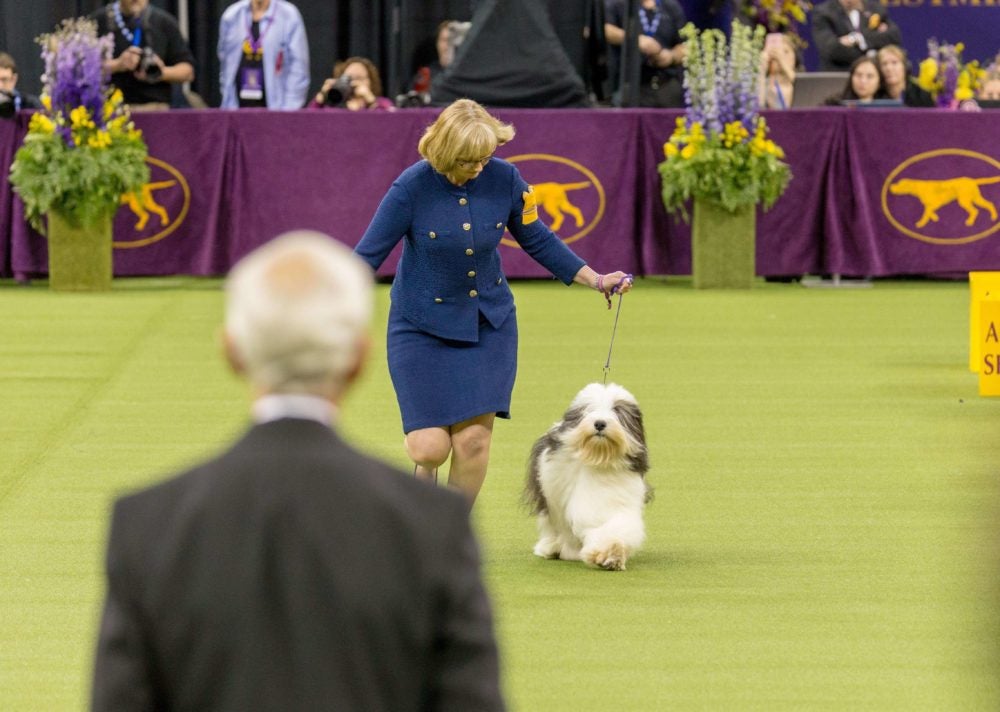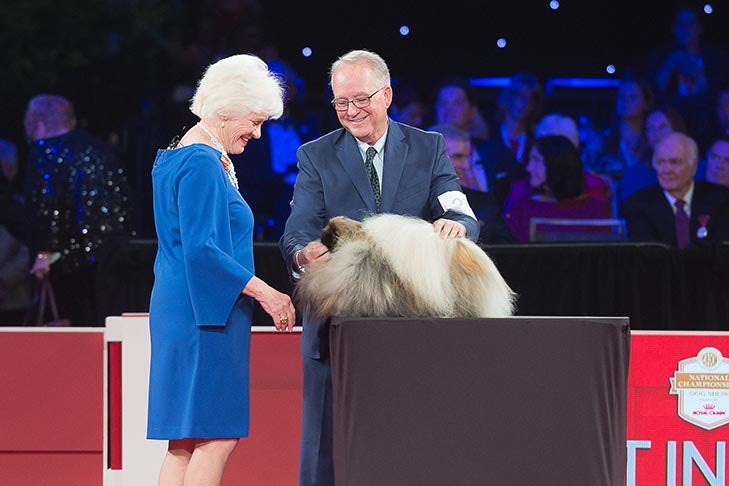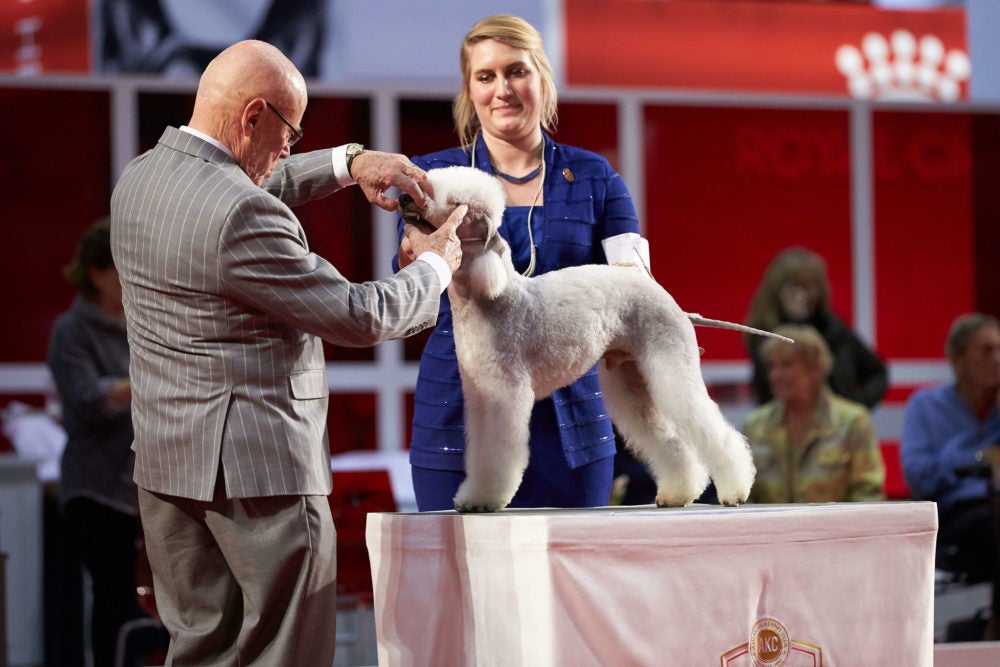There are two kinds of pointers at dog shows.
The first type is the Pointer, an elegant dog with a dished face, tail shaped like a bee stinger, and the hard-wired instinct to signal the location of camouflaged birds with the slow-motion lift of a front paw.
The other pointers, by contrast, are found in every ring. Being human, they have opposable thumbs, but instead use their index fingers to gesture in the direction of the day’s winners, rewarding them with ribbons of varying colors and sizes.
By definition, dog shows must have not only dogs but also qualified arbiters who judge them. These badge-sporting adjudicators appear pressed out of the same mold – uniformly poised and confident and dressed conservatively. But dog-show judges are made, not born. Understanding how they got to the middle of that white-gate-encircled ring may be an eye-opener to those who are new to dog shows, or who only watch them on TV once or twice a year.
Are You Experienced?
Liking dogs isn’t the only requirement for becoming a dog-show judge. Experience and accomplishment are the ultimate prices of admission. As participants in dog shows, all judges started off on the receiving end of the judging process. The first breeds they are permitted to apply for are ones they have personal experience with, usually as a breeder.
American Kennel Club policy requires that breeders who are prospective judges have a minimum of 12 years experience in their breed, having bred and raised at least five litters in their own home, and breeding or owning four or more champions from those same litters. In addition, they must pass tests on dog anatomy and ring procedure (more on that later); have been a ring steward (a sort of judges’ assistant who hands out armbands, calls in each class, and readies the ribbons) at a minimum of six shows; have judged the breed at six sweepstakes or match or open shows; attended a day-long basic-judging institute, and complied with occupational eligibility requirements. (Dog-magazine publishers and professional handlers, for example, can’t be dog-show judges.)
Breeders aren’t the only candidates who can aspire to the judge’s badge. Longtime handlers, both retired professionals and amateurs, as well as stud-dog owners can also apply. They must have a tenure of at least 15 years and have achieved certain milestones, such as owning a dog that has sired at least four champions or personally exhibiting at least four dogs of that breed to their championships.
 In Process
In Process

Once the AKC has verified the criteria on a new judge’s application, it’s time for the interview, in which the would-be judge sits down with an AKC field representative. Together they discuss the basics of the breed – its origins, function, and standard, which is the written description of how a breed should look, move and act.
They also discuss the ins and outs of ring procedure: What does a judge do if a dog starts limping? Or a latecomer arrives? Or a dog’s armband number is wrong in the judge’s book? (The answers, respectively: Excuse it for lameness. Let the tardy dog in if you wish, as long as you have not yet marked your judge’s book. And call for the superintendent, who is the only one at the show permitted to make entry-related changes to that aforementioned sacred document.)
This obsession with rule-following may sound petty, but in this highly competitive sport, it’s important to have clarity at all times. Dog shows even legislate politeness: Exhibitors who are heard to use profanity, for example, risk having their dog-showing privileges suspended.
Someone to Watch Over Me
With that nerve-rattling interview over – and, hopefully, passed – the new judge is finally ready to accept assignments. Since many show chairs select their judging panels a year or more in advance, it might take what seems like an eternity for a judge’s dance card to fill up. And once the newly minted judge – called a “permit judge,” since they are technically on probation – enters the ring, an AKC rep will be watching to make sure all the rules are being followed.
Following correct procedure sounds easier than it actually is. Think of judging dogs as sort of like driving a car: You can read and study as much as you like, but nothing prepares you for mastering those brake and gas pedals, to say nothing of the clutch! Judges are allotted only two and a half minutes to examine each dog, and if they run late, that initiates a domino effect that alters the timing of the rest of the show.

And while judges are ultimately focused on picking the best dogs, there are so many other things to remember: Did they check the bite, or teeth? Did they feel for two testicles on all male dogs? (The presence of just one – or none – requires a dog to be disqualified.) Did they mark their judge’s book correctly to note all absentees as well as winners? Did they catch ineligible class entries, like the brindle Mastiff who was mistakenly entered in the Open Fawn class? Did they give out the right ribbons in the right order? The list goes on and on.
Three’s the Charm
If new judges survive their required assignments with passing reports from the AKC’s field representatives, they are eligible to apply for “regular status.” This means they are formally approved to judge their breed and no longer need to be officially observed. If found wanting, they might be required to judge more assignments on permit status, until they are deemed ready to proceed.
Heed the Breed
The opinions of breeder-judges – that is, judges who have bred the breed they are judging – are often well regarded, as they have a depth of experience that others outside the breed usually lack. While an unschooled onlooker might think that a Labrador Retriever breeder who is judging a Sporting Group might favor the Lab in the lineup, the opposite is usually the case: Because they have such insight into their breed, breeder-judges tend to be tougher on their own. So if our hypothetical Lab breeder does indeed point to their own breed for a ribbon, look closer – it’s probably a good one.
Above Reproach
The best judges judge “without fear or favor” – they are there to pick quality dogs, whether handled by their best friend or their sworn enemy. But to avoid conflicts of interest, the American Kennel Club has strict rules about who can and cannot show to a judge. For example, someone who co-owns a dog with a judge or a member of a judge’s household cannot show any dog they own or co-own to that judge, regardless of breed. Professional handlers who have been hired by a judge to handle a dog are barred from showing any dogs to them for at least four months.
Sometimes, no matter what the degrees of separation, judges may decide that they are simply uncomfortable judging a particular dog – perhaps they bred it, or are close friends with the handler. In such cases, they simply excuse the dog and handler. While this happens infrequently, it’s no big deal in the dog world, whose tight-knit culture invariably produces occasional conflicts. In those cases, the best judgment a judge can use is to avoid even the appearance of impropriety.

Expanding Territory
While some judges are content to stop at their own breed, others want to widen their horizons and judge different ones.
Let’s return to our automotive analogy: A judge’s breed is like their own car – nothing if not familiar. Just as you don’t have to flip through your owner’s manual to figure out where the hazard lights are, breeder-judges aren’t stumped by their own breed standards. But judging another breed is like renting a car of a different make and model – you’ll need some keen observation to figure out the fine points, and at first they likely won’t come automatically.
To address this learning curve, prospective judges must accumulate “continuing education units” in a given breed, earning credit for attending seminars and performance events, watching and discussing a sizeable entry of the breed with a mentor, and taking online courses at the AKC’s Canine College. Once the educational experiences on their application have been verified, they again sit for an interview to discuss the breed’s history and standard, and must judge a specified number of assignments. While not every judging assignment will be observed, a certain number are required to be; after those observations, permit judges sit down with the field rep yet again to discuss the merits of the dogs they judged.
There are many more rules and caveats that govern a judge’s progression – including a limit to the number of breeds a judge can apply for and how fast they can be green-lighted to judge them. That’s because, like experts in any field, good dog-show judges are always still learning. As they stand in the middle of that ring, they are invariably always in the middle of their own education, too.

